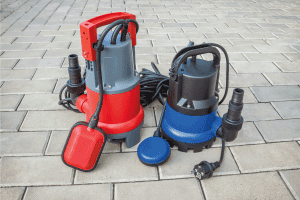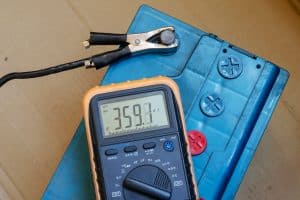You have been enjoying a dry basement only to one day find moisture on the floor. This continues despite numerous efforts to get rid of it. What could be the problem? Is it the basement floor sweating and what can you do about it? The experts we consulted offered the following solutions.
Yes, basement floors can sweat. It could be one of the reasons why your floor is constantly wet. But mitigating this problem necessitates doing any of the following:
- Use a high volume low-speed fan.
- Use a dehumidifier.
- Use a concrete sealer.
- Install a vapor barrier.
Continue reading to find out why concrete floors sweat, how to stop them, and the dangers they present. We'll also cover signs of moisture on a concrete floor. Before we delve into the solutions of a sweating floor, let us first find out what causes it in the first place.
![Empty Black Wall with Wet Concrete Floor. Can Basement Floors Sweat [And What To Do About It]](https://basementing.com/wp-content/uploads/2022/01/Empty-Black-Wall-with-Wet-Concrete-Floor.-Can-Basement-Floors-Sweat-And-What-To-Do-About-It-683x1024.png)
Why Does Your Floor Sweat?
Condensation is the main reason your concrete sweats and mostly happens during the hot season. When warm air from outside comes into contact with the cold concrete, the air cools causing it to condense on the surface leading to wetness.
If the condensation is not curbed, the concrete floor will end up developing white patches that are caused by moisture evaporating from the same concrete floor that earlier absorbed the moisture. The white patches are mineral deposits left behind during the process.
Another reason that would cause your floor to sweat is the lack of barriers under the floor. Concrete absorbs moisture from under the ground, and if there is no barrier, it will pass through, causing your floor to sweat.
How To Tell What Is Causing Your Floor To Sweat
You can easily determine whether your floor is sweating because of condensation or from the moisture beneath the concrete by using a dampness test.
Take a 16-inch square piece of plastic and seal it completely by taping it to a dry floor. When signs of wetness begin to appear, remove the plastic.
If the inside part of the plastic is wet and the rest of the floor is dry, then it is an indication your floor is absorbing moisture from the ground below. But, if the underside of your patch is dry and the rest of the floor is wet, then it is caused by condensation.
How To Stop Your Floor From Sweating
To stop your floor from sweating, you can choose to do any of these steps:
Use A High Volume Low Speed (HVLS) Fan
Have a look at this HVLS fan on Amazon.
There are ceiling fans much bigger than the residential fans, which are at least 7 feet in diameter that can move high volumes of air at low speeds of 8 mph.
Because of their long blades, the HVLS fans move large volumes of air downwards to the floor, creating an airflow that is similar to a natural breeze, making the temperature go lower by 10 to 12 degrees.
When the air cools down, there is little chance for the concrete floor to sweat because the air and floor temperatures become consistent with each other. The warm air will not be able to condense on the floor surface.
Use A Dehumidifier
Check out this dehumidifier on Amazon.
A dehumidifier takes out the moisture from your home by drawing warm air into the fan and condensing it inside the appliance instead of outside. Then it releases dry air, which will reduce the moisture on your floor.
A suitable humidity level to lower the moisture levels is between 30 to 50 percent. Humidifiers have meters in them that you can set to the percentage you want.
Use A Concrete Sealer
If you suspect that water has been seeping up your basement from the underground, the best option to counteract this problem is by sealing the concrete.
Carry out a dampness test as explained above to confirm that the sweating on your floor is caused by water seeping up your floor from the ground beneath.

Below are the basic steps to seal your basement floor:
1. Clean The Floor
Clean your floor, thoroughly removing all dirt, debris, and any mold that could have grown on it. Use a vacuum or sweep well and then scrub using a mop.
Afterward, use four parts of warm water to one part bleach to clean the floor. The bleach in the solution will kill all mold and mildew. Pay close attention to the corners where mold and insects are most likely to be found.
Depending on your preference, you could hire a rotary floor scrubber with an abrasive pad to clean the concrete thoroughly.
2. Dry The Floor
When you are done cleaning, dry the floor using a wet-dry vacuum.
Before you apply the seal, it is important to make sure the floor is completely dry. You could use a dehumidifier to remove the moisture, or a floor fan to circulate the air and speed-up evaporation.
Use the dampness test to ensure there is no moisture.
3. Seal The Floor
Have a look at this two-part epoxy sealer on Amazon.
A two-part epoxy concrete sealer will be a suitable choice if your floor is sweating because it is absorbing moisture from under the ground. Apply using the rolling or spray method, covering a small area at a time. Don’t apply too much sealer at any one time as bubbles may form on the surface.
Allow 24 hours for the sealer to dry before applying a second coat. The epoxy formula requires that for every new application; use a new mix of the formula.
4. Install A Vapor Barrier
View this vapor barrier on Amazon.
Concrete generally absorbs moisture from the ground beneath and can cause your basement floor to sweat. Though costly, a vapor barrier can be installed to block the moisture from passing through the concrete and into your basement.
The best time to install it is during construction, but it can still be installed on an existing home.

Are There Dangers On A Sweating Floor?
A sweating floor can pose a few dangers which include:
Slippery Floor
A floor that constantly has moisture can get slippery, creating a potential hazard for the occupants of a home as they might fall and hurt themselves.
Mold And Mildew
Mold and mildew thrive in a damp environment, and if nothing is done about it, it can cause health problems and damage to furniture or anything wooden due to rot. Mold can lower the quality of air when it produces musty and unpleasant smells.

How Can You Spot Moisture On A Concrete Floor?
Moisture can lead to very expensive repairs. To avoid this, the following are signs that your concrete floor has moisture:
- Unexplained cracks or splits on the concrete
- White residue on the concrete floor
- Dark discoloration on the concrete
- Black spots at the bottom of the walls or any other flooring material
- Musty smells
- The air is unusually moist
![sweaty concrete floor with puddle of water. Can Basement Floors Sweat [And What To Do About It]](https://basementing.com/wp-content/uploads/2021/12/sweaty-concrete-floor-with-puddle-of-water.-Can-Basement-Floors-Sweat-And-What-To-Do-About-It.png)
In Closing
Concrete floors can sweat due to condensation caused during a hot day, or from water seeping from the underground. But it is a problem that can be solved by using a dehumidifier, sealant, high volume low-speed fan, or installing a vapor barrier.
Spotting the signs of a sweating floor will help you curb the problem in its early stages, saving you huge repair costs.
Before you go, you may want to check out other posts on basement floors:
Cracks In A Basement Floor Are They Normal And When To Worry?







